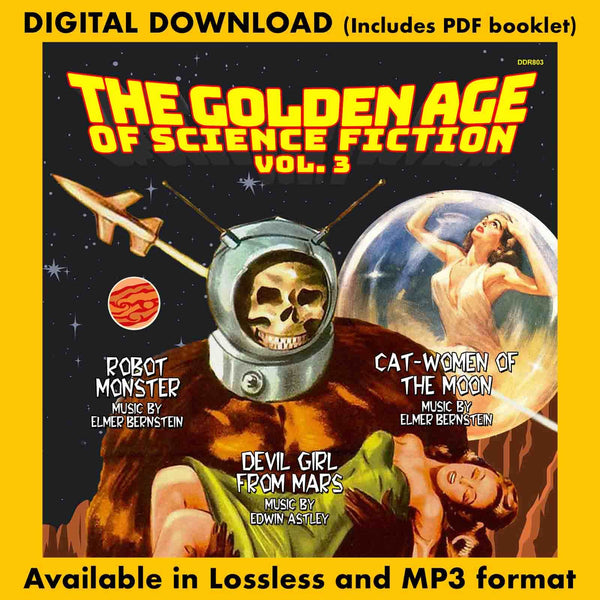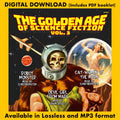
Release Date:
Downloads include choice of MP3, WAV, or FLAC
DDRDG803
Includes Digital Booklet
Click Here for CD Release
Dragon’s Domain is proud to present the third volume in their Golden Age series with three more classic original scores by musical masters of the genre.
CAT-WOMEN OF THE MOON (1953) was an early work by legendary composer Elmer Bernstein, who went on to score such popular movies as STRIPES and GHOSTBUSTERS. Released September 3, 1953, this film shares a plot similar to a movie released just five months earlier, ABBOTT AND COSTELLO GO TO MARS— wherein an alien society is led by beautiful women who seduce visiting Earth astronauts. This has now become a familiar and overused trope in science-fiction films.
CAT-WOMEN OF THE MOON stretched its limited budget with costumes and Chesley Bonestell lunar background paintings recycled from DESTINATION MOON (1950), plus the space ship interior set was borrowed from PROJECT MOONBASE (released to theaters just one day later).
ROBOT MONSTER, released 2 months after the original INVADERS FROM MARS, shares a similar theme of an alien invasion as seen through a young boy’s dream. Filmed for a fraction of INVADER’S $290,000 budget at an estimated cost of $16,000 (with a quarter of that funding its 3D process), ROBOT MONSTER made a sizable profit, grossing $1 million.
Bernstein’s score used only an 8-piece ensemble, yet his theme for the character of Ro-Man is very effective and memorable, thanks in part to the unusual inclusion of chimes, which have become synonymous with the film.
DEVIL GIRL FROM MARS comes from “across the pond,” produced in England by American brothers Edward and Harry Danzinger. Their prolific output during the 1950s and 60s was due to a belief that nothing should be wasted, especially pre-booked studio space. They would frequently commission a script to take advantage of standing sets when a production managed wrap up early. Such was the case with 1954’s DEVIL GIRL FROM MARS when CALLING SCOTLAND YARD, a series of theatrical featurettes (compiled into the 1956 NBC-TV series ADVENTURE THEATER) left the brothers with studio space reserved and paid for in advance.
Only his third film credit, the score was composed by Edwin Astley (1922-1998). Strongly influenced by jazz, he played both the clarinet and saxophone, frequently performing in various ensembles during and after World War II. In 1953, he began film scoring for the Danzinger Brothers before becoming known worldwide for his memorable work in the British made ITC TV series DANGER MAN (aka SECRET AGENT, 1960), THE SAINT (1962), and THE CHAMPIONS (1968).
This third volume in this Dragon’s Domain Records series has been mastered by James Nelson at Digital Outland. Exclusive liner notes by author David Hirsch explores these classic films from sci-fi craze of the 1950s.
SPECIAL NOTE: These recordings were originally taken from analog masters and music & effects tracks and therefore certain limitations from the source tapes may be evident. We have tried to preserve as closely as possible, the quality of the original recordings.
Reviews:
The Golden Age of Science Fiction, Vol. 3 ***
Dragon’s Domain’s latest collection in their Golden Age of Science Fiction series features scores from three mid-1950s B movies, two of them representing very early works by Elmer Bernstein (1922-2004), and the other from British composer Edwin Astley (1922-1998).
The Bernstein scores are among his first credited forays into feature work. First up is 1953’s Cat-Women of the Moon, which leads off with menacing brass to provide requisite tension. A delicate flute idea in “Moonwalk to the Caves” counters the monster music and showcases some of the composer’s lyrical skill. “Welcome Dance of Seduction” boasts keyboard material that seems improvised, but it develops into an interesting syncopated idea, and something of a Ten Commandments precursor.
Next up is the music for Robot Monster, also from 1953. Working with a budget that afforded him a mere eight orchestral players, Bernstein crafts an appropriate score highlighted by its main theme. The main title is a standout, with its avant-garde piano style enhanced by a variety of percussion effects. As it turns out, Robot Monster is more interesting than the large-scale Cat-Women of the Moon.
Edwin Astley is perhaps best known for his work on The Saint (1962-69), but he scored a myriad of films and series in the 1950s and ’60s, often interpolating jazz elements. The low-budget Devil Girl From Mars is one of many such projects by the composer, and he delivers a score that’s fairly standard for the genre and period. “Strong Emotions” features a bit more contemporary writing that makes it stand out, while a battery of percussion highlights other sections of the score.
Theatrical trailer tracks serve as buffers between the three scores on offer here. Overall, these are the types of soundtracks that may be considered faceless and forgettable, but they also represent historical curiosities, particularly in the case of the Bernstein outings. As often happened during the era, the music and other effects tracks were archived together on one source, so there are some SFX elements at play here, but the material has been cleaned up as best as possible. For additional information and samples, head to BuySoundtrax’s website. —Steven A. Kennedy
THE GOLDEN AGE OF SCIENCE FICTION: VOL. 3
Various Artists
$8.95
Downloads include choice of MP3, WAV, or FLAC
DDRDG803
Includes Digital Booklet
Click Here for CD Release
Dragon’s Domain is proud to present the third volume in their Golden Age series with three more classic original scores by musical masters of the genre.
CAT-WOMEN OF THE MOON (1953) was an early work by legendary composer Elmer Bernstein, who went on to score such popular movies as STRIPES and GHOSTBUSTERS. Released September 3, 1953, this film shares a plot similar to a movie released just five months earlier, ABBOTT AND COSTELLO GO TO MARS— wherein an alien society is led by beautiful women who seduce visiting Earth astronauts. This has now become a familiar and overused trope in science-fiction films.
CAT-WOMEN OF THE MOON stretched its limited budget with costumes and Chesley Bonestell lunar background paintings recycled from DESTINATION MOON (1950), plus the space ship interior set was borrowed from PROJECT MOONBASE (released to theaters just one day later).
ROBOT MONSTER, released 2 months after the original INVADERS FROM MARS, shares a similar theme of an alien invasion as seen through a young boy’s dream. Filmed for a fraction of INVADER’S $290,000 budget at an estimated cost of $16,000 (with a quarter of that funding its 3D process), ROBOT MONSTER made a sizable profit, grossing $1 million.
Bernstein’s score used only an 8-piece ensemble, yet his theme for the character of Ro-Man is very effective and memorable, thanks in part to the unusual inclusion of chimes, which have become synonymous with the film.
DEVIL GIRL FROM MARS comes from “across the pond,” produced in England by American brothers Edward and Harry Danzinger. Their prolific output during the 1950s and 60s was due to a belief that nothing should be wasted, especially pre-booked studio space. They would frequently commission a script to take advantage of standing sets when a production managed wrap up early. Such was the case with 1954’s DEVIL GIRL FROM MARS when CALLING SCOTLAND YARD, a series of theatrical featurettes (compiled into the 1956 NBC-TV series ADVENTURE THEATER) left the brothers with studio space reserved and paid for in advance.
Only his third film credit, the score was composed by Edwin Astley (1922-1998). Strongly influenced by jazz, he played both the clarinet and saxophone, frequently performing in various ensembles during and after World War II. In 1953, he began film scoring for the Danzinger Brothers before becoming known worldwide for his memorable work in the British made ITC TV series DANGER MAN (aka SECRET AGENT, 1960), THE SAINT (1962), and THE CHAMPIONS (1968).
This third volume in this Dragon’s Domain Records series has been mastered by James Nelson at Digital Outland. Exclusive liner notes by author David Hirsch explores these classic films from sci-fi craze of the 1950s.
SPECIAL NOTE: These recordings were originally taken from analog masters and music & effects tracks and therefore certain limitations from the source tapes may be evident. We have tried to preserve as closely as possible, the quality of the original recordings.
Reviews:
The Golden Age of Science Fiction, Vol. 3 ***
Dragon’s Domain’s latest collection in their Golden Age of Science Fiction series features scores from three mid-1950s B movies, two of them representing very early works by Elmer Bernstein (1922-2004), and the other from British composer Edwin Astley (1922-1998).
The Bernstein scores are among his first credited forays into feature work. First up is 1953’s Cat-Women of the Moon, which leads off with menacing brass to provide requisite tension. A delicate flute idea in “Moonwalk to the Caves” counters the monster music and showcases some of the composer’s lyrical skill. “Welcome Dance of Seduction” boasts keyboard material that seems improvised, but it develops into an interesting syncopated idea, and something of a Ten Commandments precursor.
Next up is the music for Robot Monster, also from 1953. Working with a budget that afforded him a mere eight orchestral players, Bernstein crafts an appropriate score highlighted by its main theme. The main title is a standout, with its avant-garde piano style enhanced by a variety of percussion effects. As it turns out, Robot Monster is more interesting than the large-scale Cat-Women of the Moon.
Edwin Astley is perhaps best known for his work on The Saint (1962-69), but he scored a myriad of films and series in the 1950s and ’60s, often interpolating jazz elements. The low-budget Devil Girl From Mars is one of many such projects by the composer, and he delivers a score that’s fairly standard for the genre and period. “Strong Emotions” features a bit more contemporary writing that makes it stand out, while a battery of percussion highlights other sections of the score.
Theatrical trailer tracks serve as buffers between the three scores on offer here. Overall, these are the types of soundtracks that may be considered faceless and forgettable, but they also represent historical curiosities, particularly in the case of the Bernstein outings. As often happened during the era, the music and other effects tracks were archived together on one source, so there are some SFX elements at play here, but the material has been cleaned up as best as possible. For additional information and samples, head to BuySoundtrax’s website. —Steven A. Kennedy


